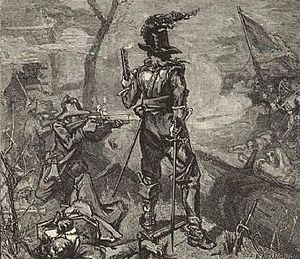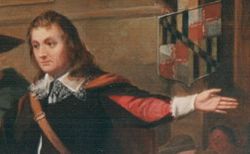Battle of the Severn facts for kids
Quick facts for kids Battle of the Severn |
|||||||
|---|---|---|---|---|---|---|---|
| Part of the War of the Three Kingdoms and Protestant Revolution of Maryland | |||||||
 Battle of the Severn, considered the last battle of the English Civil War and the first time groups of English colonists in English North America fought against one another |
|||||||
|
|||||||
| Belligerents | |||||||
| Commanders and leaders | |||||||
| Captain William Fuller | Governor William Stone | ||||||
| Strength | |||||||
| 175 | 130 | ||||||
| Casualties and losses | |||||||
| 2
(2 killed)
|
49
(17 killed
32 wounded 4 executed after the battle) |
||||||
The Battle of the Severn was a small fight that happened on March 25, 1655. It took place on the Severn River in what is now Annapolis, Maryland. At that time, the area was called "Providence" and was a settlement for Puritans.
This battle was part of bigger conflicts happening in England, known as the English Civil War. It involved Puritan settlers fighting against forces loyal to Lord Baltimore. Lord Baltimore was the owner of the Maryland colony. Some historians believe this was the very last battle of the English Civil War.
Contents
Why did the Battle of the Severn happen?
The Battle of the Severn was a result of problems that started when Maryland was first created as a colony. These problems were similar to the ones happening in England at the same time. The fight was between those who supported Lord Baltimore, who was Catholic and seen as loyal to the King, and those who supported the Commonwealth of England, who were Puritans.
Who was Lord Baltimore?
Maryland was founded by the first Baron Baltimore. He had worked for King James I. After James I died, Baltimore became Catholic and left his job. He visited what would become Maryland in 1628. He then asked King Charles I for land to create a colony where Catholics could worship freely.
After the first Lord Baltimore died, his son, Cecil Calvert, became the new Lord Baltimore. He received the land grant for Maryland.
The Charter of Maryland gave Lord Baltimore and his family special powers. They were the "absolute Lords and Proprietaries" of the new colony. This meant Lord Baltimore ruled Maryland almost like a duke.
In 1634, Lord Baltimore sent his brother, Leonard Calvert, with the first settlers to Maryland. These settlers included both Catholics and Protestants. They landed in what is now St. Mary's City. Cecil Calvert made his brother Leonard the first governor of the new colony.
However, a man named William Claiborne already had a claim to Kent Island. He had set up a fur trading post there in 1631 for the colony of Virginia. Lord Baltimore claimed Kent Island because his charter said he could take land that was "not cultivated or planted." This led to a small naval battle in 1635. Leonard Calvert eventually took Kent Island by force in 1638.
Claiborne was very upset about losing Kent Island. His anger caused problems in Maryland for many years.
How did the English Civil War affect Maryland?
The English Civil War (1642-1651) directly impacted Maryland. This war was fought between King Charles I's supporters and the English Parliament. After the war, England was ruled by Oliver Cromwell, who was called the Lord Protector. The king was removed, and England became a Commonwealth. The conflict finally ended in 1661 when Charles II became king again.
In 1643, Governor Leonard Calvert went to England to talk with his brother, Lord Baltimore. He left Giles Brent in charge. During this time, a supporter of Parliament named Captain Richard Ingle caused trouble in Maryland. Ingle later joined forces with Claiborne. In 1644, Ingle captured St. Mary's City, and Claiborne took back Kent Island. Calvert had to escape to Virginia.
This period was known as the Plundering Time. For almost two years, Ingle and his group robbed people in the colony. This ended in 1646 when Calvert returned from Virginia, recaptured St. Mary's City, and brought back order.
The settlement of Providence

After Leonard Calvert died in 1647, Cecil Calvert chose William Stone to be governor in 1649. Stone was a Protestant, and most of his council members were also Protestants. This choice was made to show that Maryland was not just for Catholics and that Protestants were not treated unfairly.
Stone and his council had to promise not to stop people from worshiping freely. In 1649, the colony passed the "Act Concerning Religion," also known as the Toleration Act. This law made sure everyone in Maryland had religious freedom.
During England's Commonwealth rule, Virginia remained loyal to King Charles II. However, Parliament said supporting the king was treason. Lord Baltimore and Governor Stone did not take a clear side at first. But Stone soon allowed a group of Puritans from Virginia, who were being treated badly, to settle in Maryland. They settled in a place called Providence, which is now Annapolis.
The question of Maryland's loyalty became clearer when Thomas Greene, Stone's deputy, declared in 1649 that Charles II was the rightful heir to the throne. Also, all laws passed by Maryland's Assembly now required an oath of loyalty to Lord Baltimore.
Changes in Maryland's government
In 1651, rumors spread that Lord Baltimore might lose his charter. Parliament sent two special representatives, one of whom was Claiborne, to make Virginia accept Parliament's authority. These representatives believed Maryland also fell under their power. In 1652, they removed Stone as governor but put him back in charge a few months later.
In 1654, Stone said that even though he was loyal to the Commonwealth, all official documents should still be in Lord Baltimore's name. The Puritans in Providence told the representatives that they did not like having to swear loyalty to Baltimore, who was Catholic. So, on July 20, 1654, Stone was forced to resign as governor.
The Parliament's representatives became the actual governors of Maryland. They held a new assembly in October 1654. Catholics and anyone who had fought against Parliament could not be members. This meant mostly Puritans were in charge. This new group passed laws that removed the Toleration Act and stopped Catholics from practicing their faith.
Governor Stone's return
On January 31, 1655, a ship called The Golden Lyon arrived in Maryland. Its captain, Roger Heamans, learned that William Stone was no longer governor. Soon after, another ship, The Golden Fortune, arrived with a letter from Oliver Cromwell, the Lord Protector of England. The letter was addressed to "Captain Stone, Governor of Maryland."
Stone saw this letter as proof that he was still the rightful governor. He challenged the authority of the Parliament's representatives. He took back the colony's official records and gathered his troops to fight the Puritan settlers. Stone recruited men from St. Mary's County, got the records back, and sailed with a small fleet towards Providence.
The Battle of the Severn

Captain Heamans was told about a plan to attack the people of Providence and burn his ship. The women and children from Providence were moved to The Golden Lyon for safety. The Puritan leaders then held a meeting and chose William Fuller to be their military leader. On March 23, 1655, they asked Heamans to help them, and he agreed, even though he had been given different orders.
On March 24, 1655, Heamans fired at boats heading towards his ship, forcing them to retreat. He then blocked Spa Creek, where Stone's forces had gone, to prevent their escape. On March 25, Captain Fuller used the only Commonwealth flag in the colony as his battle flag. The two forces met on Horn Point. Fuller's forces quickly pushed Stone's small group to the end of the peninsula.
In less than 30 minutes, the battle was over. Seventeen of Stone's men were killed. Four others were executed after the battle, including Thomas Hatton, the colony's secretary. Thirty-two men were wounded, including Governor Stone. Only two of Fuller's men were killed.
Governor Stone surrendered after being promised mercy. However, after the fighting, the Puritan council decided to give severe punishments to Stone and nine others. Four of the prisoners were executed. But the rest, including Stone, were saved when the women of Providence begged for their lives.
What happened after the battle?
The Puritan assembly stayed in power until April 27, 1658. At that time, Lord Baltimore got his colony back. Religious freedom was brought back, and everyone involved in the battle was given a general amnesty (forgiveness). So, Lord Baltimore kept his lands and powers. He also avoided the harsh fate of many others in England during this time. Lord Baltimore appointed Josias Fendall to be the new governor because of his loyalty during the battle.
The long-standing issue with Claiborne was finally settled in 1657. Lord Baltimore forgave Claiborne for all his past actions. Virginia gave up any claim to Maryland territory. Claiborne also received large land grants in Virginia to make up for losing Kent Island.
Governor Fendall soon had disagreements with Lord Baltimore. In 1659, he and Fuller led a peaceful change in Maryland's government to be more like England's Commonwealth. However, when Charles II became king again in 1660 (the Restoration), Fendall was forced to leave. Lord Baltimore's ownership of Maryland was restored. Phillip Calvert replaced Fendall as governor. Also, Fuller's property was taken away, and Claiborne never got Kent Island back.
Images for kids


